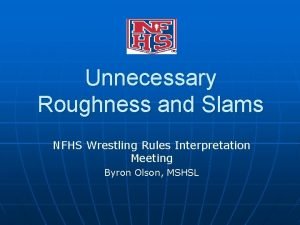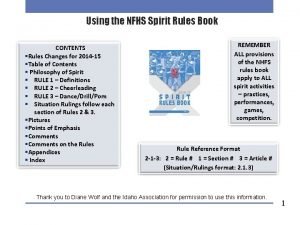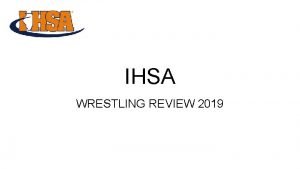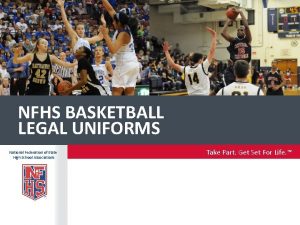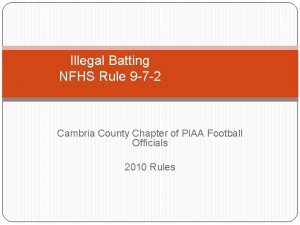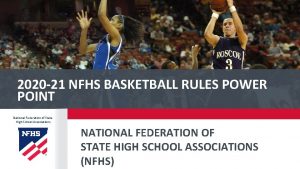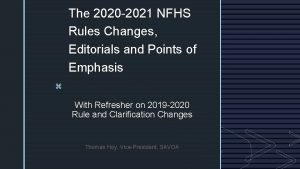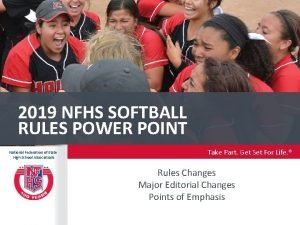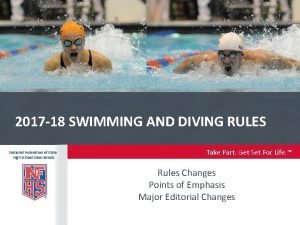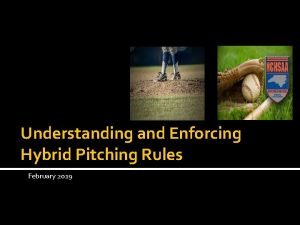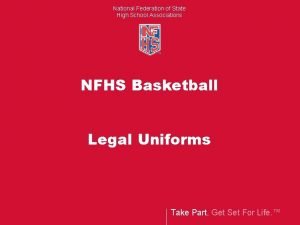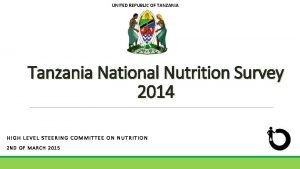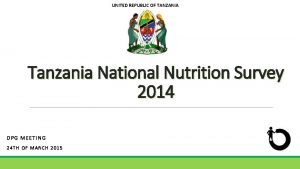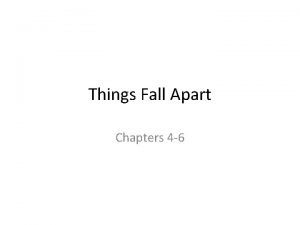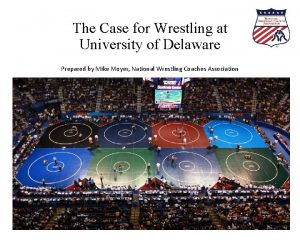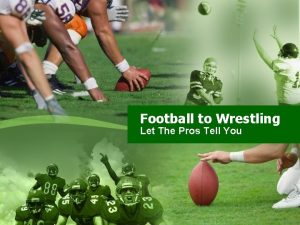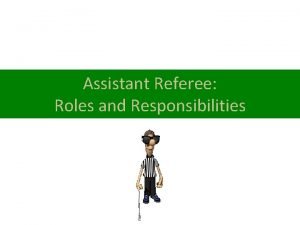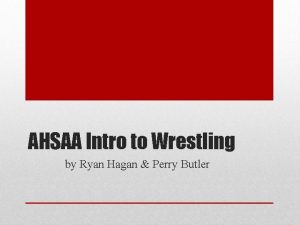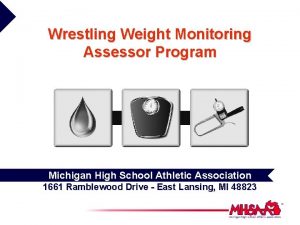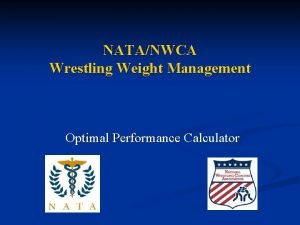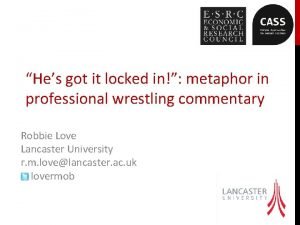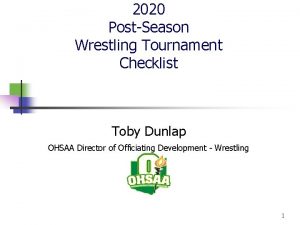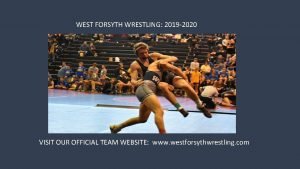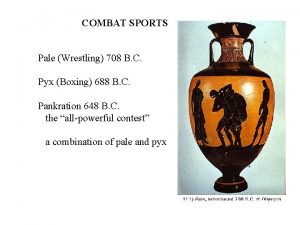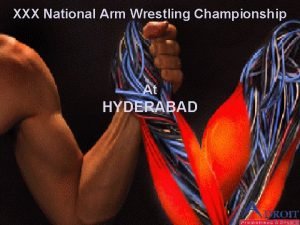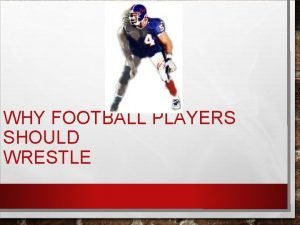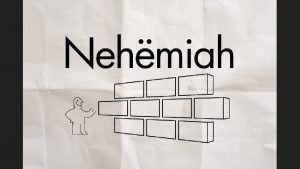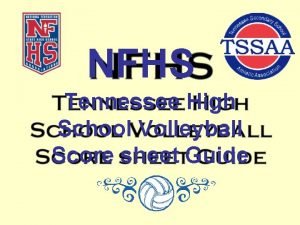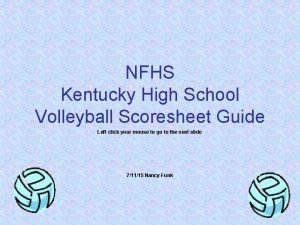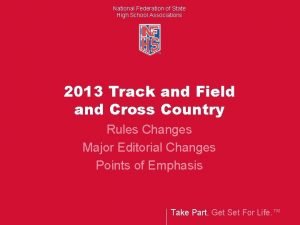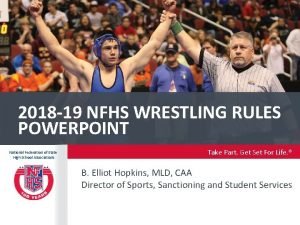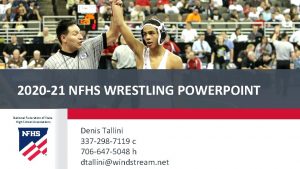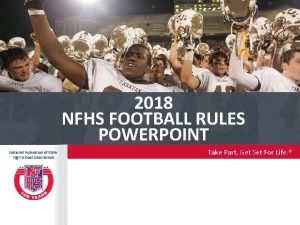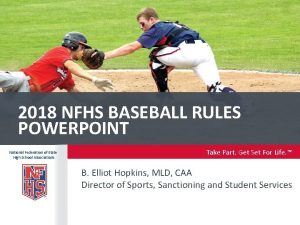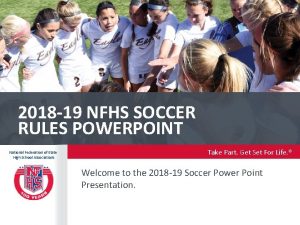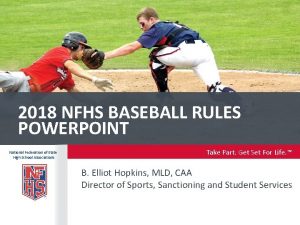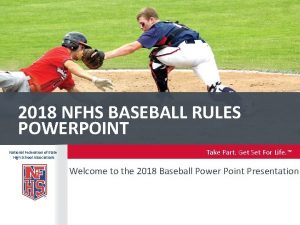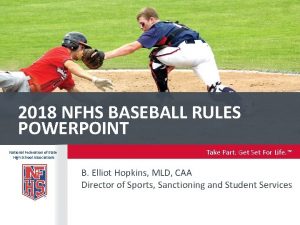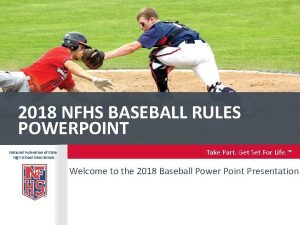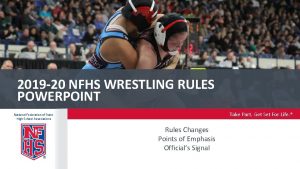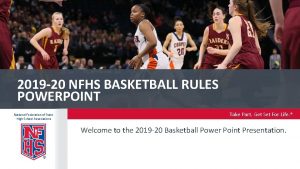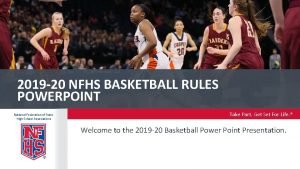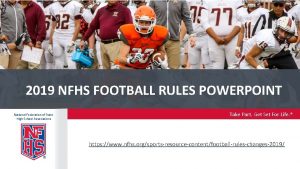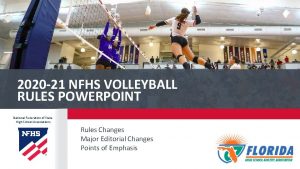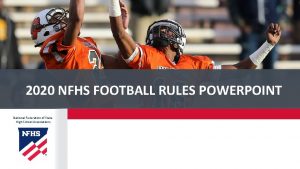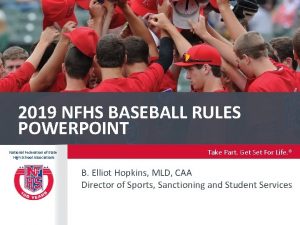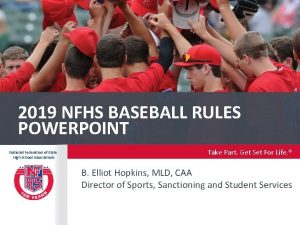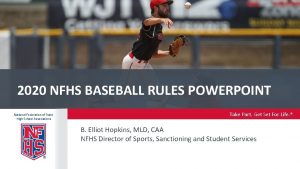2018 19 NFHS WRESTLING RULES POWERPOINT National Federation
























































- Slides: 56


2018 -19 NFHS WRESTLING RULES POWERPOINT National Federation of State High School Associations Take Part. Get Set For Life. ® B. Elliot Hopkins, MLD, CAA Director of Sports, Sanctioning and Student Services

NFHS WRESTLING RULES CHANGES

Rule Change UNIFORMS RULE 4 -1 -2 A B Any manufacturer's logo/trademark/reference that appears on the wrestling uniform can be no more than 2 1/4 square inches with no dimension more that 2 1/4 inches and may appear no more than once on each item of uniform apparel (Play. Pic A). No additional manufacturer’s logo/trademark nor a promotional reference shall be allowed on the wrestling uniform (Play. Pic B). www. nfhs. org

Rule Change UNIFORMS RULE 4 -1 -2 § ART. 2. . . Any manufacturer's logo/trademark/reference that appears on the wrestling uniform can be no more than 2 1/4 square inches with no dimension more that 2 1/4 inches and may appear no more than once on each item of uniform apparel. No additional manufacturer’s logo/trademark nor a promotional reference shall be allowed on the wrestling uniform. www. nfhs. org

Rule Change UNIFORMS RULE 4 -1 -2 § Rationale: Additional logos, trademarks and promotional markings are frequently being applied to the wrestling uniform. This rule allows for minimal disruption of the sanctity of the wrestling uniform and attempts to prevent the exploitation of students. www. nfhs. org

Rule Change WEIGH-INS RULE 4 -5 -7 Contestants may wear low-cut socks during weigh-ins that cannot be removed or added if the wrestler does not make weight. www. nfhs. org

Rule Change WEIGH-IN RULE 4 -5 -7 § ART. 7. . . All contestants shall weigh in wearing a suitable undergarment that completely covers the buttocks and groin area. Female contestants must also wear a suitable undergarment that covers their breasts. Contestants may wear low-cut socks that cannot be removed or added if the wrestlers do not make weight. www. nfhs. org

Rule Change WEIGH-IN RULE 4 -5 -7 § Rationale: Risk minimization. Feet are typically not inspected during a normal skin check. The wearing of low-cut socks will give contestants an option to prevent the spreading of athlete’s foot and other foot infections. www. nfhs. org

Rule Change ESCAPE RULE 5 -10 A B The defensive wrestler in Play. Pic A scores an escape in Play. Pic B because he/she has gained a neutral position and there are two supporting points of either wrestler inbounds. www. nfhs. org

Rule Change ESCAPE RULE 5 -10 § An escape is when the defensive wrestler gains a neutral position and the opponent has lost control, beyond reaction time, while a total of two supporting points of either wrestler are inbounds. The total of two supporting points could be two supporting points of one wrestler or one supporting point of each wrestler. www. nfhs. org

Rule Change ESCAPE RULE 5 -10 § Rationale: This rule defines what an escape is in conjunction with the new definition of supporting points. This simplifies the explanation with any combination of two supporting points of either wrestler is considered inbounds. www. nfhs. org

Rule Change INBOUNDS RULE 5 -15 -1 Contestants are considered to be inbounds if a total of two supporting points of either wrestler are inside or on the boundary lines. The total of two supporting points could be two supporting points of one wrestler or one supporting point of each wrestler that are inside or on the boundary lines. www. nfhs. org

Rule Change INBOUNDS RULE 5 -15 -1 § ART. 1. . . Contestants are considered to be inbounds if a total of two supporting points of either wrestler are inside or on the boundary lines. (Photo 11) The total of two supporting points could be two supporting points of one wrestler or one supporting point of each wrestler that are inside or on the boundary lines. www. nfhs. org

Rule Change INBOUNDS RULE 5 -15 -2 a Supporting points are the parts of the body touching the wrestling area which bear the wrestler's weight, other than those parts with which the wrestler is holding the opponent. www. nfhs. org

Rule Change INBOUNDS RULE 5 -15 -2 c In a pinning situation when all parts of a defensive wrestler shoulders / scapula are beyond the boundary line, if the feet including toes and heels of the offensive wrestlers are the supporting points, the offensive wrestlers knee(s) must be inside the boundary, whether in contact with or above the mat. www. nfhs. org

Rule Change INBOUNDS RULE 5 -15 -2 c In a pinning situation when all parts of a defensive wrestler shoulders / scapula are beyond the boundary line, if the feet including toes and heels of the offensive wrestlers are the supporting points, the offensive wrestler’s knee(s) must be inside or on the boundary, whether in contact with or above the mat. www. nfhs. org

Rule Change INBOUNDS RULE 5 -15 -2 a-c § ART. 2. . . Supporting points are the parts of the body touching the wrestling area which may or may not bear the wrestler's weight, other than those parts with which the wrestler is holding the opponent. § a. When down on the mat, the usual points of support are: § 1. the knee(s); § 2. the side of the thigh; § 3. the buttocks; www. nfhs. org

Rule Change INBOUNDS RULE 5 -15 -2 a-c § 4. the hand(s); § 5. the head. § b. When the defensive wrestler is on their back while the supporting points of either wrestler are inbounds wrestling shall continue. In this situation any part of a defensive wrestler's shoulder or scapula is considered to be all the supporting points. www. nfhs. org

Rule Change INBOUNDS RULE 5 -15 -2 c § c. Near-fall points or fall shall be earned only while the supporting points of either wrestler are inbounds. In a pinning situation, when all parts of the defensive wrestler’s shoulders/scapula are on the mat area beyond the boundary line, if the feet including toes and heels of the offensive wrestler are the supporting points, the offensive wrestler’s knee(s) must be inside the boundary, whether in contact or above the mat. www. nfhs. org

Rule Change INBOUNDS RULE 5 -15 -3 The total of two supporting points could be two supporting points of one wrestler or one supporting point of each wrestler that remain inbounds. If there is no action at the edge of the mat, the referee shall stop the match. www. nfhs. org

Rule Change INBOUNDS RULE 5 -15 -3 Even if the defensive wrestler has two supporting points inbounds, if there is no action at the edge of the mat, the referee shall stop the match for a restart in the center of the mat. www. nfhs. org

Rule Change INBOUNDS RULE 5 -15 -3 A 2 A 1 Wrestling shall continue as long as a total of two supporting points of either wrestler are inside or on the boundary lines. In this Play. Pic, the wrestlers are inbounds. The bottom wrestler’s elbows and hands are the two supporting points. www. nfhs. org

Rule Change INBOUNDS RULE 5 -15 -3 § ART. 3. . . Wrestling shall continue as long as a total of two supporting points of either wrestler are inside or on the boundary lines. The total of two supporting points could be two supporting points of one wrestler or one supporting point of each wrestler that remain inbounds. If there is no action at the edge of the mat the referee shall stop the match. www. nfhs. org

Rule Change INBOUNDS RULES 5 -15 -1, 2 AND 3 § Rationale: This rule removes the subjectivity in the out of bounds call without increasing the out of bounds area. In addition, it assists the referee’s call out of bounds more consistently. Changing the knees to knee(s) is consistent with sub-article 5 -15 -2 a 4. The removal of “majority of weight” criteria will aid the referee in focusing on the supporting points that are inbounds instead of what is out of bounds. www. nfhs. org

Rule Change INBOUNDS RULES 5 -15 -1, 2 AND 3 § This simplifies the determination with any combination of two supporting points is considered inbounds. The modification clearly defines the offensive wrestler’s supporting points in a pinning situation. No wrestling action at the edge of the mat will result in the referee stopping the match. www. nfhs. org

Rule Change SUPPORTING POINTS COMMENT § Interscholastic wrestling is uniquely different than any other type of wrestling in the world. We are challenged by a wide variety of gymnasiums and mat sizes. The NFHS Wrestling Rules Committee had a healthy discussion regarding toes, feet and heels as supporting points. There was no action taken to add toes, feet or heels as usual supporting points down on the mat. They were also not addressed as unusual supporting points. www. nfhs. org

Rule Change SUPPORTING POINTS COMMENT § Toes, feet and heels down on the mat and knees inbounds are addressed during a fall or near-fall only. (5 -15 -2 c) § Supporting points will apply to all positions. The only exception would be near-fall/fall out of bounds where the knees cannot go past the boundary line if the offensive wrestler’s weight is on their feet, toes or heels. www. nfhs. org

Rule Change OUT OF BOUNDS RULE 5 -18 Out of bounds occurs when there are no longer two total supporting points inside or on the boundary line. The total of two supporting points could be two supporting points of one wrestler or one supporting point of each wrestler inside or on the boundary line. www. nfhs. org

Rule Change OUT OF BOUNDS RULE 5 -18 § Out of bounds occurs when there are no longer two total supporting points inside or on the boundary line. The total of two supporting points could be two supporting points of one wrestler or one supporting point of each wrestler inside or on the boundary line. (Photo 11) www. nfhs. org

Rule Change OUT OF BOUNDS RULE 5 -18 § Rationale: This rule would eliminate the subjectivity in the out-of- bounds call without increasing the out-of-bounds area. It also assists the referees call out of bounds more consistently. The removal of the “majority of weight” criteria will aid the referee in focusing on inbounds and out-of-bounds, rather than trying to make a judgment on weight-bearing extremities. www. nfhs. org

Rule Change REVERSAL RULE 5 -22 -1 -2 In awarding a reversal at the edge of the mat, control must be established while the total of two supporting points of each wrestler inside or on the boundary line. The total of two supporting points could be two supporting points of one wrestler or one supporting point of each wrestler inside or on the boundary line or while at least the feet of the scoring contestant finish down on the mat inbounds. www. nfhs. org

Rule Change REVERSAL RULE 5 -22 -1 § ART. 1. . . It is a reversal when the defensive wrestler comes from underneath and gains control of the opponent, either on the mat or in a rear-standing position, while the total of two supporting points are inside or on the boundary line. Two supporting points could be two supporting points of one wrestler or one supporting point of each wrestler. If there is no action at the edge of the mat, the referee shall stop the match. (Photos 21 & 22) www. nfhs. org

Rule Change REVERSAL RULE 5 -22 -2 § ART. 2. . . In awarding a reversal at the edge of the mat, control must be established while the total of two supporting points of each wrestler inside or on the boundary line. The total of two supporting points could be two supporting points of one wrestler or one supporting point of each wrestler inside or on the boundary line or while at least the feet of the scoring contestant finish down on the mat inbounds. www. nfhs. org

Rule Change REVERSAL RULE 5 -22 -1 -2 § Rationale: This rule defines what a reversal is in conjunction with the new definition of supporting points. This simplifies the explanation with any combination of two supporting points of either wrestler is considered inbounds. No wrestling action at the edge of the mat will result in the referee stopping the match. www. nfhs. org

Rule Change STALLING RULE 5 -24 -3 e, f From a neutral position, the wrestler from behind is stalling if he/she pulls their opponent out of bounds off the mat. It is also stalling if a wrestler pushes their opponent out of bounds off the mat. www. nfhs. org

Rule Change STALLING RULE 5 -24 -3 e A B C The wrestlers in Play. Pic A are in a neutral position. In Play. Pic B, the wrestler in gray is backing off the mat. That is stalling. It is not stalling if the wrestler backs off the mat to pivot to get into position to execute a move (Play. Pic C). www. nfhs. org

Rule Change STALLING RULE 5 -24 -3 e, f § § § § ART. 3. . . It is stalling in the neutral position when a wrestler: a. continuously avoids contact with the opponent; b. plays the edge of the mat; c. prevents the opponent from returning to or remaining inbounds; or d. is not attempting to secure a takedown; e. backing off the mat, out of bounds; f. pushing or pulling out of bounds. www. nfhs. org

Rule Change STALLING RULE 5 -24 -3 e, f § Rationale: The addition of these two criteria has contributed to keeping the action within the boundary lines at different positions. This modification of stalling in the neutral position has made the stalling call an easier call for the official with definitive language as a guide. www. nfhs. org

Rule Change TAKEDOWN RULE 5 -25 -3 In awarding a takedown at the edge of the mat, control must be established while a total of two supporting points of either wrestler are in bounds. The total of two supporting points could be two supporting points of one wrestler or one supporting point of each wrestler that are inbounds or while at least the feet of the scoring contestant finish down on the mat inbounds. www. nfhs. org

Rule Change TAKEDOWN RULE 5 -25 -1 § ART. 1. . . It is a takedown when, from the neutral position, a wrestler gains control over the opponent down on the mat and a total of two supporting points of either wrestler are inbounds. The total of two supporting points could be two supporting points of one wrestler or one supporting point of each wrestler that are inbounds. When the defensive wrestler’s hand(s) touch the mat it is considered a supporting point(s). (Photos 23 -30) www. nfhs. org

Rule Change TAKEDOWN RULE 5 -25 -3 § ART. 3. . . In awarding a takedown at the edge of the mat, control must be established while a total of two supporting points of either wrestler are in bounds. The total of two supporting points could be two supporting points of one wrestler or one supporting point of each wrestler that are inbounds or while at least the feet of the scoring contestant finish down on the mat inbounds. (Photos 32 -34) www. nfhs. org

Rule Change TAKEDOWN RULE 5 -25 -3 § Rationale: This rule defines what a takedown is in conjunction with the new definition of supporting points. This simplifies the explanation with any combination of two supporting points of either wrestler is considered inbounds. www. nfhs. org

Rule Change RECOVERY TIME RULES 5 -28 -3, 8 -2 -2 A B C From the neutral position (Play. Pic A), a wrestler false starts (Play. Pic B) causing an injury to their opponent. The injured wrestler is allotted 2 minutes of recovery time (Play. Pic C), which is not deducted from the injured wrestler’s injury time allowance. If the injury is such the injured contestant is unable to continue following a maximum of two minutes recovery time, the injured contestant shall be awarded the match by default. www. nfhs. org

Rule Change RECOVERY TIME RULES 5 -28 -3, 8 -2 -2 § ART. 3. . . Recovery time, If a contestant is injured as a result of an illegal hold/maneuver, unnecessary roughness, unsportsmanlike conduct during the match or the result of a false start (by the opponent) in the neutral position, the wrestler is entitled to two minutes of recovery time, which is not deducted from the injured wrestler’s injury time allowance. (8 -2 -2) www. nfhs. org

Rule Change RECOVERY TIME RULE 8 -2 -2 § ART. 2. . . If a contestant is injured as a result of an illegal hold/maneuver, unnecessary roughness, unsportsmanlike conduct (during the match) or the result of a false start (by the opponent) in the neutral position, to the extent the injured contestant is unable to continue following a maximum of two minutes recovery time, the injured contestant shall be awarded the match by default. www. nfhs. org

Rule Change RECOVERY TIME RULE 8 -2 -2 § In case of an intentional attempt to injure an opponent, the offender shall be penalized for flagrant misconduct. Recovery time for injury because of an illegal hold/maneuver is not deducted from the injured contestant’s injury-time allowance. An injured contestant cannot take injury time immediately following recovery time. (5 -28 -3) www. nfhs. org

Rule Change RECOVERY TIME RULES 5 -28 -3, 8 -2 -2 § Rationale: Clarification that if a wrestler is injured because of the opponent’s false start in the neutral position, then the injured wrestler should be accommodated with recovery time as part of the existing criteria. www. nfhs. org

Rule Change ILLEGAL HOLD/MANEUVER RULE 7 -1 -5 q § Under the Illustrations section in the back of the NFHS Wrestling Rules book. Illustration #83 "(7 -1 -5 q) The back bow is illegal as illustrated by application. " when the pressure is toward the head, whether the defensive wrestler is on his/her stomach or hip. § Rationale: In the body of Rule 7, it is denoted that the "back bow" is an illegal hold/maneuver. It does not stipulate that it is illegal conditionally if pressure is used, if it is applied, then it is illegal. www. nfhs. org

Rule Change ILLEGAL HOLD/MANEUVER RULE 7 -1 -5 y The nelson cradle is illegal. It is a combination made up of a half nelson on one side with a locked cradle from around the neck with the far side knee. The crotch of the knee acts as the other arm (arm pit) to complete the full nelson pressure on the neck and throat. www. nfhs. org

Rule Change ILLEGAL HOLD/MANEUVER RULE 7 -1 -5 y § y. the Nelson-Cradle. § Rationale: Modified that the Nelson-Cradle is an illegal hold/maneuver. The Nelson. Cradle is a combination made up of a half nelson on one side with a locked cradle from around the neck with the far side knee. The crotch of the knee acts as the other arm (arm pit) to complete the full nelson pressure on the neck and throat. www. nfhs. org

Rule Change ILLEGAL HOLD/MANEUVER RULE 7 -1 -5 y § Also, the action occurring on the lower spine as the knee is brought up near the head is dangerous. When the move is finished the offensive wrestler can either roll it over or draw it backward. www. nfhs. org

Rule Change UNSPORTSMANLIKE CONDUCT RULE 7 -4 -2 Repeatedly dropping to one knee or one hand to break locked hands is to be ruled unsportsmanlike conduct. www. nfhs. org

Rule Change UNSPORTSMANLIKE CONDUCT RULE 7 -4 -2 § ART. 2. . . Unsportsmanlike conduct involves physical or nonphysical acts and they can occur before, during or after a match. It includes, but is not limited to, such acts as failure to comply with the direction of the referee, pushing, shoving, swearing, taunting, intimidation, baiting an opponent, throwing ear guards or any other equipment, spitting and the clearing of the nasal passage in other than the proper receptacle, repeatedly dropping to one knee or one hand to break locked hands, … www. nfhs. org

Rule Change UNSPORTSMANLIKE CONDUCT RULE 7 -4 -2 …indicating displeasure with a call, failure to keep shoulder straps up while on the mat and failure to comply with the end-of-match procedure. Continuing acts of unsportsmanlike conduct or any unsportsmanlike conduct may be construed as flagrant misconduct. § Rationale: Repeatedly dropping to one hand to force an opponent to break locked hands happens just as often as repeatedly dropping to one knee. There is no difference between the two acts. www. nfhs. org

Rule Change UNSPORTSMANLIKE CONDUCT RULE 7 -4 -2 § This has been enforced by many officials without proper rule coverage. This conduct is now being addressed in the rules book. www. nfhs. org
 Nfhs wrestling rule changes
Nfhs wrestling rule changes Are slams legal in wrestling
Are slams legal in wrestling Nfhs cheerleading rules
Nfhs cheerleading rules Ihsa referee salary
Ihsa referee salary Nfhs basketball uniform rules
Nfhs basketball uniform rules Penalty for illegal kicking or batting
Penalty for illegal kicking or batting 2020-21 nfhs basketball rules book
2020-21 nfhs basketball rules book Nfhs volleyball uniform rules 2020-2021
Nfhs volleyball uniform rules 2020-2021 Nfhs softball rules
Nfhs softball rules Nfhs swimming and diving rules book
Nfhs swimming and diving rules book Nfhs libero rules
Nfhs libero rules Pitching with a hybrid
Pitching with a hybrid Nfhs basketball uniform rules
Nfhs basketball uniform rules National federation of community development credit unions
National federation of community development credit unions Que letra continua m v t m j
Que letra continua m v t m j Tanzania national nutrition survey 2018
Tanzania national nutrition survey 2018 Tanzania national nutrition survey 2018
Tanzania national nutrition survey 2018 Kvs regional sports meet 2018-19
Kvs regional sports meet 2018-19 Q2 national patient safety goals
Q2 national patient safety goals National service framework children
National service framework children National business group on health conference 2018
National business group on health conference 2018 2018 national patient safety goals
2018 national patient safety goals National geographic photo contest 2018
National geographic photo contest 2018 Trent hoover wrestling
Trent hoover wrestling Chapter 4 summary things fall apart
Chapter 4 summary things fall apart Colleen strickland
Colleen strickland University of delaware wrestling
University of delaware wrestling Football players that wrestled
Football players that wrestled Wrestling officials and their duties
Wrestling officials and their duties Ryan hagan wrestling
Ryan hagan wrestling Wrestling weight cut calculator
Wrestling weight cut calculator Peleus
Peleus Prior lake youth wrestling
Prior lake youth wrestling Ohsaa middle school wrestling weigh in sheet
Ohsaa middle school wrestling weigh in sheet Wrestling hydration test calculator
Wrestling hydration test calculator Wrestling metaphors
Wrestling metaphors Ohsaa wrestling weight classes
Ohsaa wrestling weight classes Wrestling tournament checklist
Wrestling tournament checklist Wrestling parent meeting agenda
Wrestling parent meeting agenda West forsyth wrestling
West forsyth wrestling Wrestling weight descent calculator
Wrestling weight descent calculator Does clemson have a wrestling team
Does clemson have a wrestling team Pale wrestling
Pale wrestling North carolina high school athletic association football
North carolina high school athletic association football Hatboro horsham wrestling
Hatboro horsham wrestling Kennedy and khrushchev arm wrestling
Kennedy and khrushchev arm wrestling Dr jess demaria
Dr jess demaria Xxx werstling
Xxx werstling Why football players should wrestle
Why football players should wrestle Greek wrestling
Greek wrestling Robot wrestling
Robot wrestling Gibbs high school wrestling
Gibbs high school wrestling 3 man mechanics baseball
3 man mechanics baseball High school volleyball score sheets
High school volleyball score sheets Nfhs volleyball scoring instructions
Nfhs volleyball scoring instructions Nfhs javelin sector diagram
Nfhs javelin sector diagram Hybrid pitching stance
Hybrid pitching stance

